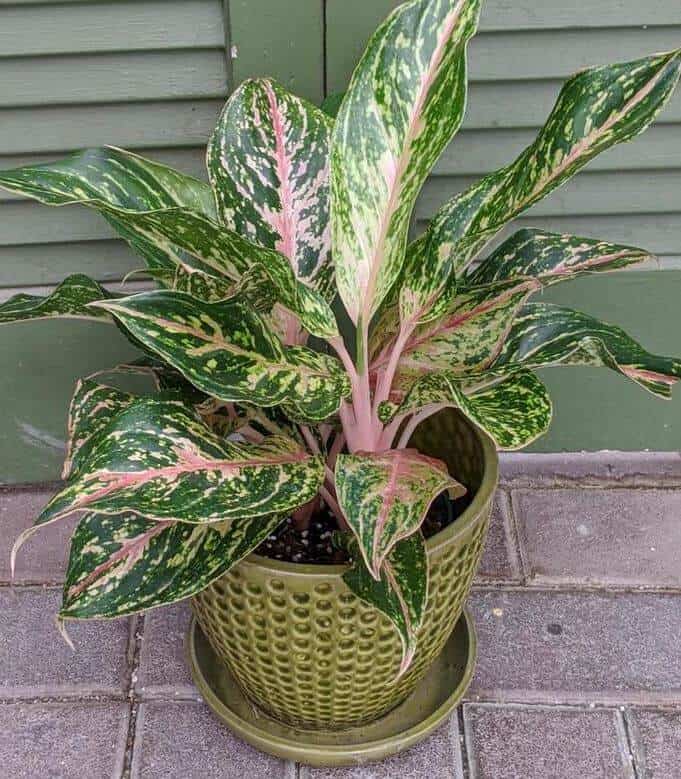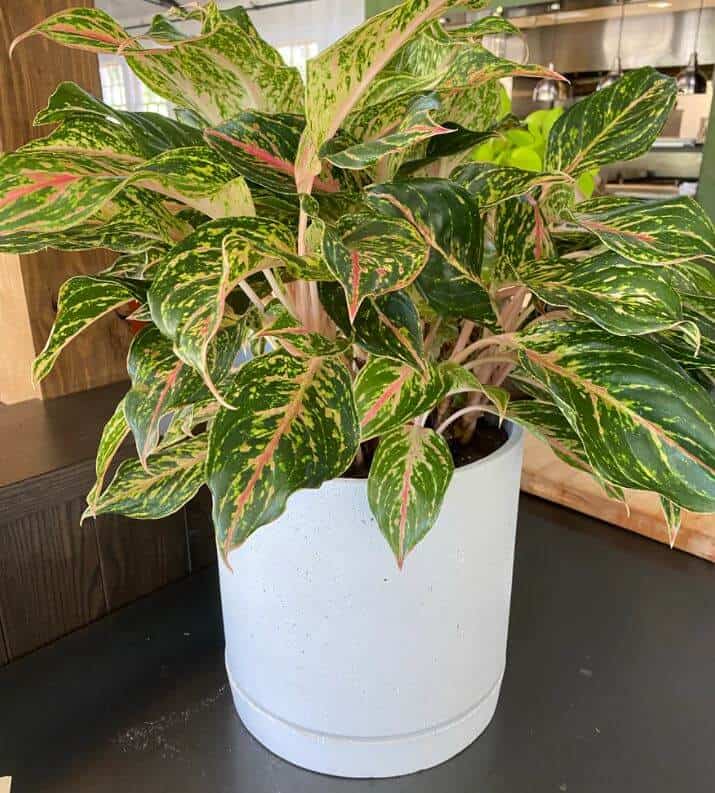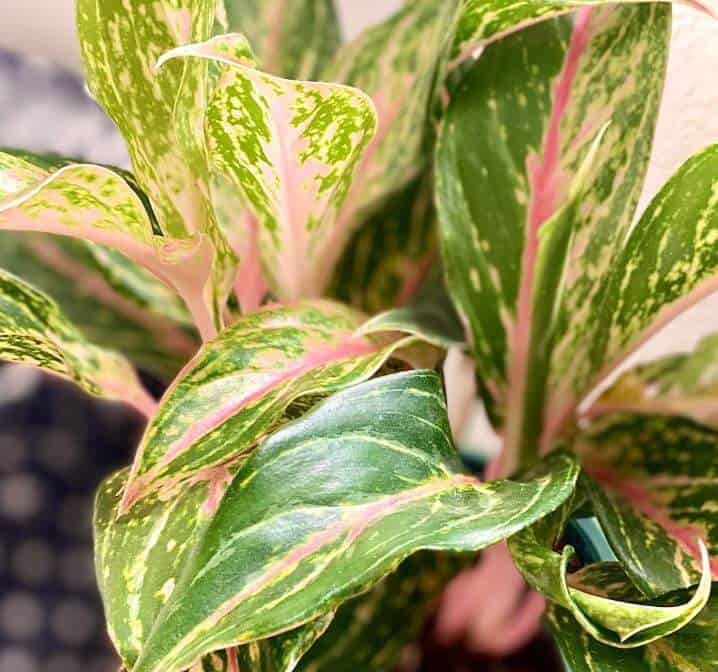Last Updated on February 13, 2023 by a Friendly Gardener
The Aglaonema Sparkling Sarah is one of the many popular Chinese Evergreen cultivars. This perennial hybrid houseplant is a native of the tropical zones in Southeast Asia. It is an easy-to-maintain plant that makes a stunning addition to any indoor home garden thanks to its vibrant colors.
A member of the Araceae plant family, Sparkling Sarah does not require much in the way of care when cultivated in the proper environmental conditions. A dose of indirect sunlight, a balanced watering schedule, and a bit of humidity and fertilizer will keep your plant glowing with health.
All About the Aglaonema Sparkling Sarah Plant

Foliage is queen when it comes to this Aglaonema. Sparkling Sarah is appreciated for its exquisite green leaves that measure 6 to 8 inches each and feature variegations of pink with yellow veins offering a burst of color. Blooms are white to pinkish in hue. This particular Aglaonema is a creeper and will maintain its colorful foliage even in autumn when other vegetation is shedding.
Sparkling Sarah can grow as much as 2 feet high and 3 feet wide with foliage growing more in width than in height. This plant does have some drought tolerance, so should you miss a watering, it is forgiving. Drought tolerance is for the occasional missed watering but should not be extended for a lengthy period.
Plant growth is slow to moderate with much depending on environmental conditions. It can be cultivated outside in USDA hardy zones 9 through 11. As an evergreen, Sarah will enter dormancy in winter.
Sparkling Sarah Plant Care

This plant is popular because, notwithstanding its showy foliage, it is a low-maintenance houseplant.
Soil
Sparkling Sarah prefers a well-draining acidic potting mix to thrive. Soil pH should measure between 6.1 and 6.5 for the best results. Use a soil pH tester and add a bit of peat moss to improve acidity if needed. To blend your own soil mix use 50% organic potting soil. The other 50% should be evenly divided between peat moss, perlite, and vermiculite to guarantee adequate aeration and drainage.
Light
This aglaonema variety will grow in various lighting conditions. It can be grown in an office or home without generous natural light. You can also use a grow light. Ideally, your plant will respond best to bright indirect sunlight in the vicinity of a window. Do not expose the leaves to direct sunlight to prevent burning.
Water
How much water your plant needs will depend on the season. During warmer summer seasons, water your Sparkling Sarah thoroughly once or twice weekly. Allow the soil bed to dry before watering again. Watering moist soil may lead to fungal infection and root rot.
Humidity

As a tropical plant, Sparkling Sarah likes moderate humidity indoors. Moisture is necessary to maintain foliage colorful and vibrant. Should leaves droop or fade, humidity levels may be too low.
You can increase humidity around your plant by using a pebble tray, a space humidifier, or even a bowl of water nearby. Misting will help but only temporarily.
Temperature
Sparkling Sarah likes moderate temperatures ranging from 65° to 80°F. It does not tolerate extremely high temperatures or frost. It also is unappreciative of drafts, so it needs to be kept away from heating and air conditioning units and vents. If you do place your plant outside for a spell, move it indoors as winter nears.
Feeding
Feeding your Sparkling Sarah will help to encourage blooming. Apply a quality houseplant fertilizer that you have diluted to half strength once monthly during the growing season.
Pruning
Should you want to shape your plant, trim leaves during the growing season. Remove any damaged or dead foliage. Begin trimming from the plant’s bottom with sterilized pruning shears.
Repotting Sparkling Sarah

Your Sparkling Sarah will generally need to be repotted once every third year. It can be moved to a slightly larger pot, approximately 1 or 2 inches wider, or you can use the same pot and just change the soil.
Sparkling Sarah Plant Propagation
This Aglaonema variety can be propagated easily using root divisions. To propagate using the division method:
- Remove your plant from its container and gently shake off excess soil.
- Untangle the roots carefully to avoid damaging them.
- Use a sterilized garden knife to cut through the root ball or root clump.
- Each section must have a stem. Plant the sections in individual pots and water.
- Place your new baby plant in indirect bright sunlight. It can be placed in direct sunlight only during the morning hours.
- Within 2 to 3 months, your new plant should be flourishing.
Another alternative is to cultivate your root division in water. Put the root section in a jar filled with approximately 50% water and position it in low light. Change the water weekly. When new roots and shoots appear, transplant the plant into a pot with soil.
Stem cuttings of 5 to 8 inches can also be utilized. Place a stem cutting in the growing medium, water it, and then move the pot to a spot with bright indirect light.
Aglaonema Sparkling Sarah Plant Problems
Aglaonemas rarely present disease problems. They can suffer from root rot, fungal infections, or curling leaves if they are overwatered.
Common houseplant pests that may invade a Sparkling Sarah include scales, mealy bugs, or spider mites. Scales and mealy bugs can be removed manually, whereas spider mites can be washed off with a spray of water. Afterward, treat your plant with insecticidal soap or with organic Neem oil.
Sparkling Sarah Toxicity
The Sparkling Sarah Aglaonema contains calcium oxalate crystals making it quite toxic to humans as well as family pets. If leaves or stems are cut or broken, they will release a sap filled with crystals. By touching the sap, you may experience a severe skin reaction. It is best to wear gardening gloves when handling the plant, especially if pruning.
Most pets will desist after one bite due to the bitter taste coupled with burning irritation and blisters in the mouth or throat. If you suspect aglaonema ingestion, get to a veterinarian or doctor as soon as possible.

